Sun, 9 June 09:00
-
09:00 - 09:45 tanzhaus, Studio 2
Smoothie
Warm-upA healthy cocktail for the body. The warm-up combines elements of yoga and somatic techniques such as Body-Mind Centering and Feldenkrais with contemporary/modern dance ideas. Joints are mobilised to enhance permeability and bodily well-being. ‘Smoothie’ is meant to assist the participants in engaging with the sitting marathon afterwards in a relaxed way.
‘Smoothie’ replaces ‘Körpertraining’
Rita Aozane Bilibio (D) dancer
-
09:00 - 09:45 tanzhaus, Studio 3
Smoothie
Warm-upA healthy cocktail for the body. The warm-up combines elements of yoga and somatic techniques such as Body-Mind Centering and Feldenkrais with contemporary/modern dance ideas. Joints are mobilised to enhance permeability and bodily well-being. ‘Smoothie’ is meant to assist the participants in engaging with the sitting marathon afterwards in a relaxed way.
Damian Gmuer (D) Capoeira teacher
Sun, 9 June 10:00
-
10:00 - 10:45 Capitol, Club Video
The Parallel Practice of Dance, Yoga and Urban Activism
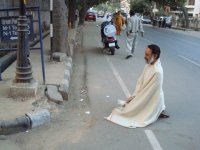 © Pavan Bisht
© Pavan BishtIndia’s self-understanding of dance is still characterised by classical dance and a self-flattering view to the past. In response to this, the Studio Abhyas founded by Navtej Johar in New Delhi combines yoga, dance and urban activism. These three at first glance totally independent body practices continuously enrich each other, thus assisting in developing a physical awareness of the present moment that puts us in a position to react to and have an impact on the complex urban reality of a megacity. Classical dance’s apolitical cult of the past is thus countered by a contemporary political form of art.
Navtej Johar (IND) choreographer
-
10:00 - 11:30 tanzhaus, Studio 2
Artistic Research Lab: The Tandem Series
‘The Tandem Series’ seeks to overcome the separation between theory and practice. One artist and one scholar each will collaborate in three tandems. The choreographer Katja Münker and the cultural theorist Ralph Fischer examine the phenomenon of “walking” in the context of performances, the dancer Paula Kramer and the philosopher Wallace Heim deal with site-specific performances dedicated to the themes of landscape, nature and ecology, and the dancer Joa Hug along with the philosopher Mónica Alarcón explore the specific knowledge that is created through the practice of dance. Finally, the impressions, insights and experiences from the tandems will be summarised by Robin Nelson in a wrap-up and evaluated in regard to the discussion on artistic research.
Concept:
Joa Hug (D) in collaboration with Paula Kramer, Katja Münker (D)Tandem 3: Embodied Knowledge
Joa Hug (D) dancer, researcher
Mónica Alarcón (D) philosopher -
10:00 - 12:00 tanzhaus, Studio 1
Emerging Artists
Between Dance Training and Dance Market
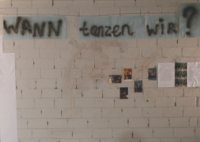 © Matthias Quabbe
© Matthias QuabbeIn the past years, numerous training courses for choreography, dance, dance mediation, and performance have been developed. The graduates are faced with a contemporary “dance market” in which the most various formats have emerged to enable the entry into the market. But are the training courses and the dance market tuned to each other? Do they complement each other – or are they possibly diametrically opposed? What does an independent production system, what do municipal and state theatres expect from young artists? Does postsecondary training take these expectations into consideration? Is “too much” training taking place?
Nik Haffner (D) choreographer, lecturer Hochschulübergreifendes Zentrum Tanz Berlin
Joanna Lešnierowska (PL) curator, dramaturge, critic Adam Mickiewicz University Poznań
Bettina Masuch (D) curator Tanz im August
Jan Pusch (D) choreographer Theater BraunschweigModeration:
Gabriele Naumann-Maerten (D) cultural manager -
10:00 - 12:00 Capitol, Studio
Mindmap
First Hour of a Handbook for Politics
On the level of municipalities and federal states, the promotion of art belongs to the so-called voluntary services. If the administration makes budget cuts, culture and therefore particularly dance are the first to be affected. What can a handbook for advising and enlightening community and state politicians look like, so that dance will become an indispensable component of the promotion of culture and remain firmly anchored in the agenda? With the aim of making dance tangible and comprehensible for politics, this lab invites participants to creatively work on the contents for a kind of “guide” on the art form of dance.
In German
With guests from the world of politics and dance
Moderation:
Arnd Wesemann (D) journalist, editor tanz
Concept:
BBTK/Bundesdeutsche Ballett- und Tanztheaterdirektoren Konferenz -
10:00 - 12:45 tanzhaus, Studio 6
Choreography, Protest, Public Sphere
 © Anja Kühn
© Anja KühnCan protest be choreographed? Can choreography be used to protest? The lab addresses the relationship between aesthetics and politics. It examines both the role of choreography in contemporary urban democracy movements and the political dimensions of artistic performances in public space: Under which conditions is an urban space transformed into a political public sphere by the means of choreography? This and other questions will be discussed based on current examples and with the aid of artistic-scientific procedures.
Gabriele Klein (D) dance scholar, sociologist
Oliver Marchart (D) sociologist
Martin Nachbar (D) choreographer
Vassilis Tsianos (D) sociologist, co-founder Kanak Attak
Margarita Tsomou (D) scholar, co-editor Missy Magazine -
10:00 - 13:00 tanzhaus, Großer Saal Video
Here is You and not Me
On the Relationship between Dance and Architecture
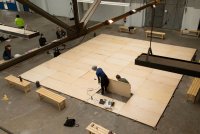 © MichaelDouglas Kollektiv
© MichaelDouglas KollektivDance and architecture structure space through both movement and distinctions. Members of the Cologne-based MichaelDouglas Kollektiv and the architect Michael Steinbusch give insights into their long-term research work on the interrelations between the two disciplines. The lab involves the participants as dancers and in simple exercises explores the interplay of bodies, space and objects.
Douglas Bateman, Michael Maurissens, Susanne Grau, Sabina Perry, Adam Ster (D) dancers, choreographers, members of MichaelDouglas Kollektiv
Michael Steinbusch (D) architect
Sun, 9 June 11:00
-
11:00 - 11:45 Capitol, Club Video
ARC.HIVE of Contemporary Arab Performing Arts
Systematic erasure and re-writing of history have been a constant feature of the political regimes in the Arab world. This also concerns the history of performing arts and artists. The Cairo-based research platform HaRaKa initiated ARC.HIVE, a project that seeks to establish a mnemonic space and structure for contemporary performing arts from Arab countries. The initiative wants to encourage the systematic collection of works by Arab artists to be stored in three physical archival sites in Africa, Europe, and the USA.
In addition, a research unit dedicated to performance and movement in the Arabic-speaking region will be set-up in Cairo. At the Dance Congress, partners of ARC.HIVE discuss issues that are of crucial importance to them such as the role of Arab arts within political change.ARC.HIVE team & think-tank:
Neveen Allouba (EGY/UK), Ismail Fayed (EGY), Daniel Peslari (RO)
Jacqueline Davies (USA) executive director New York Public Library for the Performing Arts
Maaike Bleeker (NL) cultural theorist
Burt Ramsay (UK) professor of Dance History, School of Arts, De Montfort University, Leicester, UK
Thomas Thorausch (D) deputy director Deutsches Tanzarchiv KölnModeration:
Adham Hafez (EGY) choreographer, composer, initiator HaRaKa & ARC.HIVE
Concept:
HaRaKa Dance Development and Research -
11:00 - 12:00 Capitol, Theatersaal Video
Ballet for the 21st Century
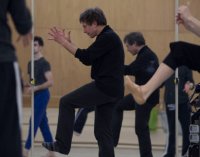 © Gert Weigelt
© Gert WeigeltIn his choreographic work, Martin Schläpfer deliberately takes up and further pursues the classical heritage. His Ballett am Rhein, where he has been the director and head choreographer since 2009, not only presents the repertory of the 20th century, but also contributes to contemporary dance with world premieres. In his lecture demonstration, Martin Schläpfer, together with his dramaturge Anne do Paço, reflects on the significance of the repertory for his ‘Ballet for the 21st Century’ and gives insights into his working method based on rehearsal excerpts from his most recent piece, ‘Nacht umstellt’.
Martin Schläpfer (D) ballet director
Anne do Paço (D) dramaturge
With dancers of the Ballett am Rhein Düsseldorf Duisburg:
Ann-Kathrin Adam, Doris Becker, Yuko Kato, Alexandre Simões -
11:00 - 12:45 tanzhaus, Studio 3
Dance and Aging
Dance in the Second Half of Life
Are older dancers capable of doing things that younger ones cannot? What can dance offer to older people? The Gesellschaft für Tanzforschung (society of dance research) presents a poster exhibition on the theme of ‘Dance and Aging/Dance in the Second Half of Life’ summarising the main results of scientific and artistic studies on the question of “aging”. In addition to promoting participation in society and enhancing bodily fitness, at issue is also what older persons can contribute to mediating dance culture. In the frame of the salon, these and other topics will be discussed with experts.
In German
Hubert Dinse (D) neurologist Ruhr-Universität Bochum
Gabriele Gierz (D) choreographer
Krystyna Obermaier (D) dance pedagogueModeration:
Christiana Rosenberg-Ahlhaus (D) sports scientist
Concept/support:
GTF/Gesellschaft für Tanzforschung -
11:00 - 13:00 tanzhaus, Studio 5
RepNet Creates Debate:
Redefining Repertory Companies?
As opposed to flexible models of work in the independent scene, repertory companies at first glance appear as static entities. What function – and what future – can companies with their own ensemble and a fixed canon of pieces have in an increasingly globalised world of dance? What are their specific strengths and weaknesses in creation and production? And not least: How can an artistic identity be forged without a permanent choreographer? Following the motto “share and learn”, the RepNet network invites choreographers, dancers, curators, cultural managers, and cultural policy makers to a round-table discussion.
RepNet is an international network founded in 2008 by five repertory companies – Carte Blanche (N), Iceland Dance Company (IS), Scottish Dance Theatre (UK), Skånes Dansteater (S), Tanzcompagnie Oldenburg (D) – with the aim of regularly and jointly providing further training for the members of their companies, as well as discussing issues related to cultural policies and triggering public debates.Honne Dohrmann (D) Direktor Tanzcompagnie Oldenburg
Bruno Heynderickx (N) artistic director Carte Blanche
Meinrad Huber (D) dance agent ecotopia dance productions
Lára Stefansdóttir (IS) dancer, choreographer
Jo Strømgren (N) choreographer Jo Strømgren KompaniConcept/support:
RepNet -
11:00 - 13:30 tanzhaus, Studio 4
Rausch
Collaboration between Movement, Sound, and Text
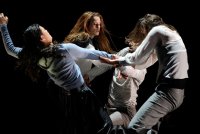 © Sebastian Hoppe
© Sebastian HoppeThe director and author Falk Richter and the choreographer Anouk van Dijk develop their pieces in an open research, writing and rehearsal process. Based on their most recent production ‘Rausch’, the workshop participants are given a view of the working mode of the two. How can dance and acting encounter each other, how can dancers and actors jointly improvise with text and movement? Who is oriented towards whom, who inspires whom, what can a joint, content-related search be like? The participants should have seen the performance of ‘Rausch’ and read the texts of Falk Richter beforehand.
Further information/texts: falkrichter.com
Registration required
Bring training clothesFalk Richter (D) director, author
Thomas Wodianka (D) actor
Nina Wollny (D) dancer
Sun, 9 June 12:00
-
12:00 - 13:30 Capitol, Club Video
Talks on Dramaturgy
The relationship between choreographers and dramaturges continuously changes during the course of their collaboration. Based on selected productions, William Forsythe, Reggie Wilson and Sidi Larbi Cherkaoui talk with their dramaturges about their role in the artistic process, about research interests and working methods. What kind of knowledge and what competences do dramaturges contribute to the process? How do the translation processes between language and movement evolve? At which moments are dramaturges especially needed and when do they disturb? Is the dramaturgic function actually only reserved to the dramaturge?
Since 2008, Guy Cools has been curating a series of so-called ‘body: language talks’ in which he questions artists on their approach to the body. For the Dance Congress, he will talk with the Flemish choreographer Sidi Larbi Cherkaoui about themes that played a role in their relationship as choreographer and dramaturge, e.g., working with bodies beyond the norm, the non-hierarchical attitude towards body images from different cultures and the special significance of bodily rhythm and energy.
Sidi Larbi Cherkaoui (B) choreographer
Guy Cools (B) dramaturge, curator -
12:00 - 13:30 tanzhaus, Kleiner Saal
On Mentoring
Jonathan Burrows presents two short talks on mentoring, written by himself and the performer Chrysa Parkinson for the What_Now Festival, London in April this year. These talks formed part of a seminar to discuss what mentoring might be, how it works, why it sometimes does not work and what the personal, political, educational and creative imperatives behind the practice are. These talks look in particular at the political aspect of mentoring and the way it has been encouraged from the outset by organisers and funding bodies rather than being a demand from artists, which is a continuing pattern and once which often colours the experience and affects the outcomes. Burrows will be joined onstage by Nik Haffner, who together will facilitate a focused discussion afterwards around the issues raised.
‘On Mentoring’ replaces ‘Writing Dance’
Jonathan Burrows (UK) choreographer
Nik Haffner (D) choreographer, lecturer Hochschulübergreifendes Zentrum Tanz Berlin -
12:30 - 14:00 Capitol, Studio
Salonfähig
Talks on Dance Heritage
The artistic adoption of dance heritage is no longer limited to reconstructions that are historically faithful to the original. Re-enactments, films, installations, or online projects deliberately utilise the historical distance for contemporary updates. Artists pass on their own choreographic work to the next generation of dancers. This results in multimedia publications such as De Keersmaeker’s ’A Choreographer’s Score’ or Forsythe’s ‘Motion Bank’.
Whereas projects funded by Tanzfonds Erbe reflect the artistic relevance of historical dance pieces and persons for contemporary choreographers.Kenneth Archer (UK) documentarian
Ramsay Burt (UK) dance scholar, De Montfort University, Leicester
Millicent Hodson (UK) choreographer
Heather Jurgensen (D) dancer, deputy ballet director Theater Kiel
Claudia Jeschke (A) dance scholar
Timmy De Laet (B) dance scholar
Antje Pfundtner (D) choreographerModeration:
Claudia Henne (D) journalist
Supported by TANZFONDS – Eine Initiative der Kulturstiftung des Bundes
Sun, 9 June 13:00
-
13:00 - 13:30 tanzhaus, Studio 1, 3, 5 & 6
TanzSprint 2013
Z. Alibert, A. Bornšek, M. Glikson, O. Scibor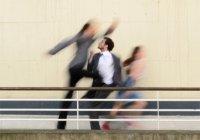 © Miranda Glikson
© Miranda GliksonEach year, students of the Frankfurt Master’s study programme Contemporary Dance Pedagogy (MAztp) organise the one-week workshop festival ‘TanzSprint’ for amateur and professional dancers. For the Dance Congress they have developed various physical-dancerly training offers from current working material on dance techniques and digital tools, which will take place daily, parallel in five studios. In teachings à 30 minutes, a broad range of new training approaches will be tested. Contemporary exchange and mediation formats provide a wide variety of experiences with the art form.
Zoé Alibert, Anja Bornšek, Patricia Gimeno, Miranda Glikson, Jason Jacobs, Gregory Livingston, Ola Scibor (D) students of MAztp
Concept:
Ingo Diehl (D) direction MAztp, Hochschule für Musik und Darstellende Kunst Frankfurt/M.Coordin8ed /Studio 1
Taking Steve Paxton’s Small Dance as a starting point, we will challenge our awareness and coordination by trying to localise centers within centers. Introducing the movement of the figure 8, we inspect elemental patterns such as walking and crawling, to then explore more complex patterns within spontaneously gener8ed dances. Within these perspectives, we move from inside out and from outside in – to perceive our bodies 3-dimensionally.
What sort of rhythms can we create in our bodies as we trace an infinite form? What kind of coordination, momentum and efficiency can we discover as we draw such a non-orientable shape? What spaces unfold in and outside of us?Zoé Alibert (D) performer, choreographer, teacher
Space Walk /Studio 3
This workshop will examine spatial environment as an extension of our selves.
Referencing spatial atmospheres and architectural principles we will physically experience how spaces organise our body and define movement behaviour. In a focused 30-minute exploration movement tasking and awareness approaches deal with the structures of our surrounds. Engaging with the notion of borders, of inside/outside and public/private realm, we explore the temporal qualities of spatial conditions.Miranda Glikson (AUS/D) dancer
What about Dancing? /Studio 5
“Let us begin with the idea that you know how to dance.” Referring to the questions Jonathan Burrows asks in ”A Choreographer’s Handbook”we set on a physical and explorative journey into the idea of dancing. “What is your relationship to the idea of dancing? What are the qualities that drew you towards dancing in the first place?” “What do you know that you have forgotten that you know?” “Forget all this.” “Just dancing is enough.”
Ola Scibor (D) dancer, interpreter, contemporary dance teacher
Collective Practice for the Spine /Studio 6
Drawing from Steve Paxton’s (Material for the Spine) and Alice Chauchat’s scoring proposal (Collective Sensations Practice), we will use our spine as a source of experiential information, allowing it to organise and establish individual moving environments. By verbally offering physically perceived information into the space, we build a score based structure. Growing and branching it collectively, enables us to tackle strategies of relations, decision-making and processes of contextualisation on an individual as well as a group level.
Anja Bornšek (D) somatic movement educator
-
13:00 - 14:00 tanzhaus, Studio 2 Video
Artistic Research Lab: The Tandem Series
Wrap-up: Synthesis Tandem Series
‘The Tandem Series’ seeks to overcome the separation between theory and practice. One artist and one scholar each will collaborate in three tandems. The choreographer Katja Münker and the cultural theorist Ralph Fischer examine the phenomenon of “walking” in the context of performances, the dancer Paula Kramer and the philosopher Wallace Heim deal with site-specific performances dedicated to the themes of landscape, nature and ecology, and the dancer Joa Hug along with the philosopher Mónica Alarcón explore the specific knowledge that is created through the practice of dance. Finally, the impressions, insights and experiences from the tandems will be summarised by Robin Nelson in a wrap-up and evaluated in regard to the discussion on artistic research.
Concept:
Joa Hug (D) in collaboration with Paula Kramer, Katja Münker (D)Wrap-up: Synthesis Tandem Series
Robin Nelson (UK) theatre scholar
Joa Hug (D) dancer, researcher
Paula Kramer (D) dancer, researcher
Katja Münker (D) dancer, choreographer
Sun, 9 June 14:00
-
14:00 - 15:30 Capitol, Club Video
Interweaving Dance Cultures
Wrap-up
The interweaving of cultures in and through dance is a tension-filled process of approximation and reciprocal exchange. Here, not only different body concepts and practices as well as various traditions of bodily representation encounter each other. Deviating methods of passing on and updating movement techniques or different models of interaction and collaboration must also be negotiated anew each time. Fellows and members of the International Research Center ‘Interweaving Performance Cultures’ will discuss in detail the forms and limits of such exchange processes together with further Congress guests during so-called tea-times.
Panelists will discuss, which traces and threads they followed during the Congress, which connections seem to have worked, what was surprising to them? How did the different presentations connect with the questions raised during the first two sessions on “Interweaving Dance Cultures”? What aspects did they miss during the past three days of the Congress, which aspects should be emphasized in the future?
Impulses by:
André Lepecki (USA) dance scholar
Sabine Sörgel (D/UK) dance scholar
Susan Manning (USA) dance scholar
Navtej Johar (IND) choreographerModeration:
Gabriele Brandstetter (D) dance scholarConcept:
Gabriele Brandstetter, Holger Hartung (D) dance scholars, Christel Weiler (D) theatre scholar International Research Center ‘Interweaving Performance Cultures’, Freie Universität Berlin
Sun, 9 June 15:00
-
15:30 - 17:00 Congress Venue
LIGNA
Tanz aller – ein Bewegungschor
A TANZFONDS ERBE Project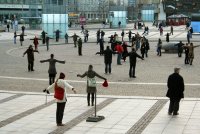 © Nicolas Reichelt
© Nicolas ReicheltThe project ‘Tanz aller’ deals with the almost forgotten heritage of movement choirs that at the end of the 1920s grasped dance as a social and political phenomenon. They aimed at “liberating” the bodies of the dancing amateurs, opening up movements for them that went beyond everyday work and allowed them to act as a chorally organised mass in urban space. The project explores the heterogeneity of this movement and looks for choreographies and stories in nine cities. With the radio ballet, the performance collective Ligna has developed a format with which choreographic interventions in public space with an audience are made possible. Can this practice be seen as an update of the movement choirs? What role can masses, what role can dance play today? What does the organisation of masses beyond representation look like? ‘Tanz aller’ examines the political claim of the movement choirs in the present-day context.
Production LIGNA
Music Felix Kubin
Supported by TANZFONDS ERBE – Eine Initiative der Kulturstiftung des Bundes
Continuous
-
Congress Venue, Foyer
Memories of Dance – Graphic Recording
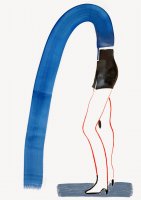 © Tiziana Jill Beck
© Tiziana Jill BeckWhat do you remember about your first, nicest, most touching, or even most terrible dance experience? Images, sounds, movements, moods, people – the illustrator Tiziana Jill Beck and her team are underway with pad and pencil to collect the memories that the Dance Congress participants give an account of, to then render them in sketches and drawings. The constantly growing collection of pictures will be presented in the Congress spaces and published on the Tanzfonds website. In this way, a common memory space of individual dance experiences and encounters will evolve – a dance history in pictures that most certainly cannot be canonised.
Tiziana Jill Beck (D/USA) illustrator
and her team: Johanna Benz, Edith Carron, Anna Hainrich, Marius Wenker
A project by TANZFONDS – Eine Initiative der Kulturstiftung des Bundes -
Capitol, Foyer
Cultural Education by German Dance Ensembles at German Theatres
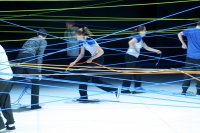 © Thomas Jauck
© Thomas JauckFor many dance ensembles in Germany, cultural education has become an important part of their daily work. It has an effect on all social groups and wins over new audiences for dance at German theatres. Whether spectators are made familiar with dance through public ballet training, rehearsal visits and talks with choreographers, or children and older people gain experiences with their own body in dance projects – these offers always result in long-term relationships and affiliations. A video documentation presents excerpts of various projects and initiatives of municipal ensembles.
Project:
BBTK/Bundesdeutschen Ballett- und Tanztheaterdirektoren Konferenz -
Capitol, Foyer
Books on the Move
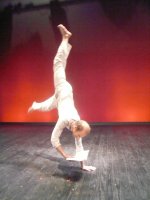 © Claude Sorin
© Claude SorinGuest of the Dance Congress: the mobile bookstore for everyone who dances, reflects and moves. The assortment of this international bookstore for contemporary dance and performance includes books on choreography, applied anatomy and body experience, as well as theoretical essays and biographies in German, English and French. New publications are on offer as well as hard-to-find books on contemporary dance.
Agnès Benoit-Nader (D) booksonthemove.eu
-
Capitol, Foyer
Dance and Aging
Poster Exhibition: Dance in the Second Half of Life
The Gesellschaft für Tanzforschung (society of dance research) presents a poster exhibition of international scientific and/or artistic projects dealing with the topic ‘Dance and Aging’.
Concept:
Gesellschaft für Tanzforschung (GTF)Ästhetisches Interesse an künstlerischem Tanz im Alter – Eine explorative Analyse biographischer Erfahrungen und tätigkeitsspezifischer Vollzugsanreize
Claudia Behrens (D) Johannes Gutenberg-Universität Mainz
Krystyna Obermaier (D) Elementarer Tanz e.V. Köln‚Zwei Flüsse‘ Ein Tanztheaterprojekt für alle ab 55 Jahren – Ein Kooperationsprojekt des Ringlokschuppen (Mülheim) und der Bergischen Volkshochschule Wuppertal
Barbara Cleff (D) Seniorentanztheater Dortmund/Ballett Dortmund
Nicole Schillinger (D) TheaterTanzPerformance ttpProject: ArtRose/Small Moments of Greatness. A collective for dancers “im erfolgreichen Alter”
Jenny Coogan (D) Palucca Hochschule für Tanz DresdenMobileDance Age: an initiative to bring dancers from different generations together in creative processes
Fiona Edwards, Jo Parkes (D) EdwardsParkesDance (EPD)An initiative to bring dancers from different generations together in creative processes
Fiona Edwards, Jo Parkes (D) EdwardsParkesDance (EPD)‚Ahnen‘ – ein Performanceprojekt mit 13 Tänzerinnen im Alter von 62 bis 84 Jahren
Gabriele Gierz (D) My Way Ensemble‘Identities’ – a production involving 5 women, dancers and choreographers over the age of 50: What is the “identity” of the older dancer?
Susanne Kempster (ES)‘Dance and Age – Expression of the Human Body at different Ages’ (Teilprojekt des Forschungsprojektes ‚One of a Kind‘, geleitet von Jiri Kylian an der Rotterdam Dance Academy, Codarts Rotterdam)
Friederike Lampert, Desiree Staverman (NL) Rotterdam Dance Academy, Codarts RotterdamTango im Altersheim: ein tanzpädagogisches Projekt
Florica Marian, Katrin Grüntzig (CH)Dying Swans and dragged up dames: a photographic exploration of the ageing dancer
Helen Newall, Mark Edward (UK) Edge Hill UniversityFreiräume schaffen: Zeitgenössischer Tanz im fortgeschrittenen Alter
Cornelia Widmer, Walter Widmer (D) ForumTanzGesellschaftstanz mit Älteren – ein Mittel zur gesundheitlichen Prävention
Eileen Wanke (D) Abteilung Tanzmedizin, Institut für Arbeitsmedizin, Charité-Universitätsmedizin Berlin/Institut für Arbeits-, Sozial- und Umweltmedizin, Goethe Universität Frankfurt et al. -
Capitol, Foyer
Motion Bank Work Station
The Motion Bank online tools can be tested here.
-
tanz blog
The journal “tanz” is accompanying the entire Dance Congress with a BLOG on tanz-zeitschrift.de. At the BLOGGING station, participants and guests of the Congress can read the BLOG entries and comment on them directly.
Editorial team:
Heike Diehm, Elena Iris Fichtner, Irmela Kästner, Melanie Suchy, Bettina Trouwborst, Arnd Wesemann.